Art World
10 Beginner’s Tips for How to See—and Understand—the Rich Complexities of Byzantine Textiles
We got some tips from Elizabeth Dospel Williams, a curator at Dumbarton Oaks.
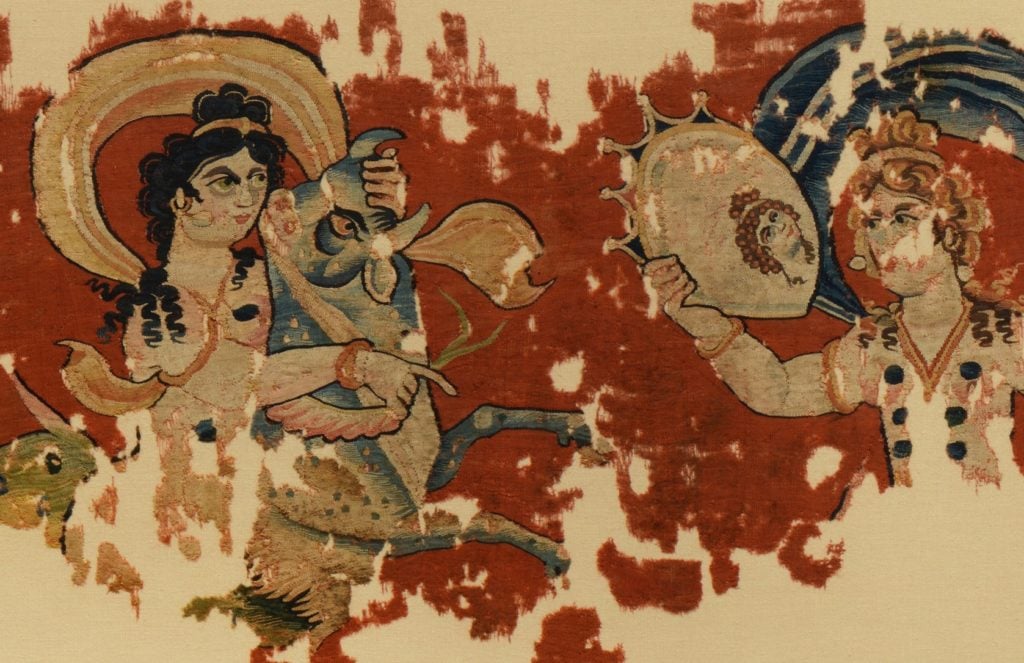
We got some tips from Elizabeth Dospel Williams, a curator at Dumbarton Oaks.

Menachem Wecker

At Dumbarton Oaks in Washington, DC, having pored over a group of Byzantine textiles from the 4th to 12th centuries with curator Elizabeth Dospel Williams, I took away this general rule for non-specialists: don’t trust your lying eyes.
In this era of “fake news” and deepfake videos, this bears explanation. You’ll see dazzling colors and compelling details in the more than 250 Byzantine textiles in the museum’s new online catalogue, but every textile isn’t created equal. Some are fake; others are slapdash. Transcendent materials and techniques rarely broadcast their rarity, so you must know where—and how—to look.
To help guide you, we’ve put together 10 tips for how to approach Byzantine textiles as a novice.
In Indiana Jones and the Last Crusade, the guardian of the holy grail tells Harrison Ford’s character that he chose wisely when he spotted the coveted object among an ostentatious lineup of vessels. And when eyeing Byzantine textiles, you similarly need to look past surface beauty.
At Dumbarton Oaks, a simple-looking child’s tunic with coarse thread doesn’t seem to offer much. But this humble garment with ancient and modern repairs—which Williams calls “the ultimate hand-me-down”—has a complex and painful story attached to it.
Like most surviving Byzantine textiles, the tunic comes from an Egyptian grave, where it was buried with an infant or a toddler, underscoring a deep tragedy. Someone embroidered two crosses on the tunic (one above the child’s chest, and one on the back), perhaps for amuletic purposes.
“My heart is always so touched by the slit,” Williams says. “I think of baby onesies today. It just transports you.” (So does a green child’s hooded “poncho” at the Metropolitan Museum.)
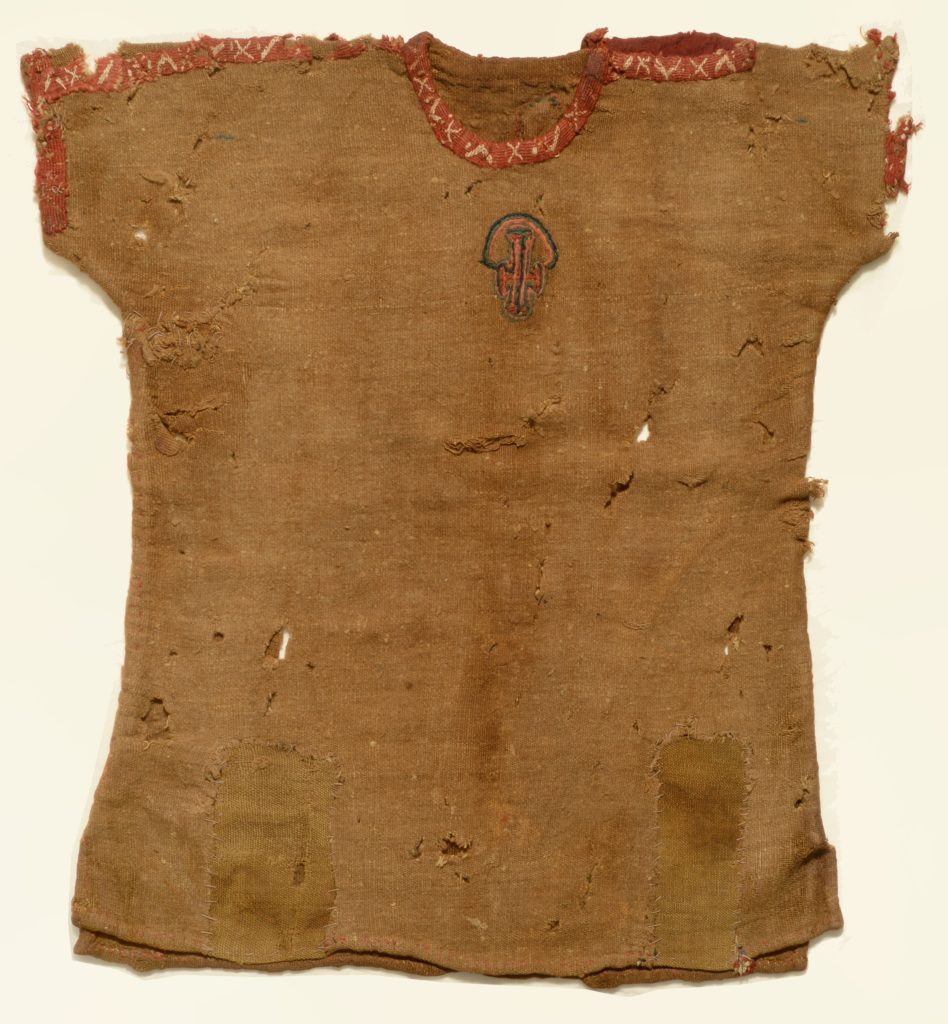
Egyptian child’s tunic, circa the 4th to 10th century.
The Christian connotations of the crosses on the above child’s tunic are unambiguous. But the meaning of a cross is not always so obvious.
In one drawer Williams opened, a rectangular embroidered fragment contained a small yellow cross circumscribed within a larger red-brown one. (Many dealers cut fragments out of larger pieces either to discard stains or to split up and sell particularly attractive parts.) The piece, from Egypt and made between the 7th and 10th centuries, is unusual in that explicit religious connotations are uncommon in textiles of that era. But the item doesn’t necessarily only carry Christian meaning.
“While a Christian connotation may indeed be intended here, it is not certain that the piece came from a fabric exclusively for Christian use or meaning,” according to a catalogue entry.
Williams, whose dissertation was on jewelry, says overt Christian imagery is surprisingly rare on textiles as compared to on jewelry, especially given that both were worn. Even into the early Islamic period, Dionysius was a popular textile motif.
In the museum’s Hestia hanging, a star of the collection, a hearth goddess is portrayed with Marian echoes. “Egypt is such a fascinating microcosm of Christianization,” Williams says. “They’re not one moment not-Christian, and the next moment Christian. In fact, they keep beliefs that continue for a very long time. The textiles really bear witness to that.”
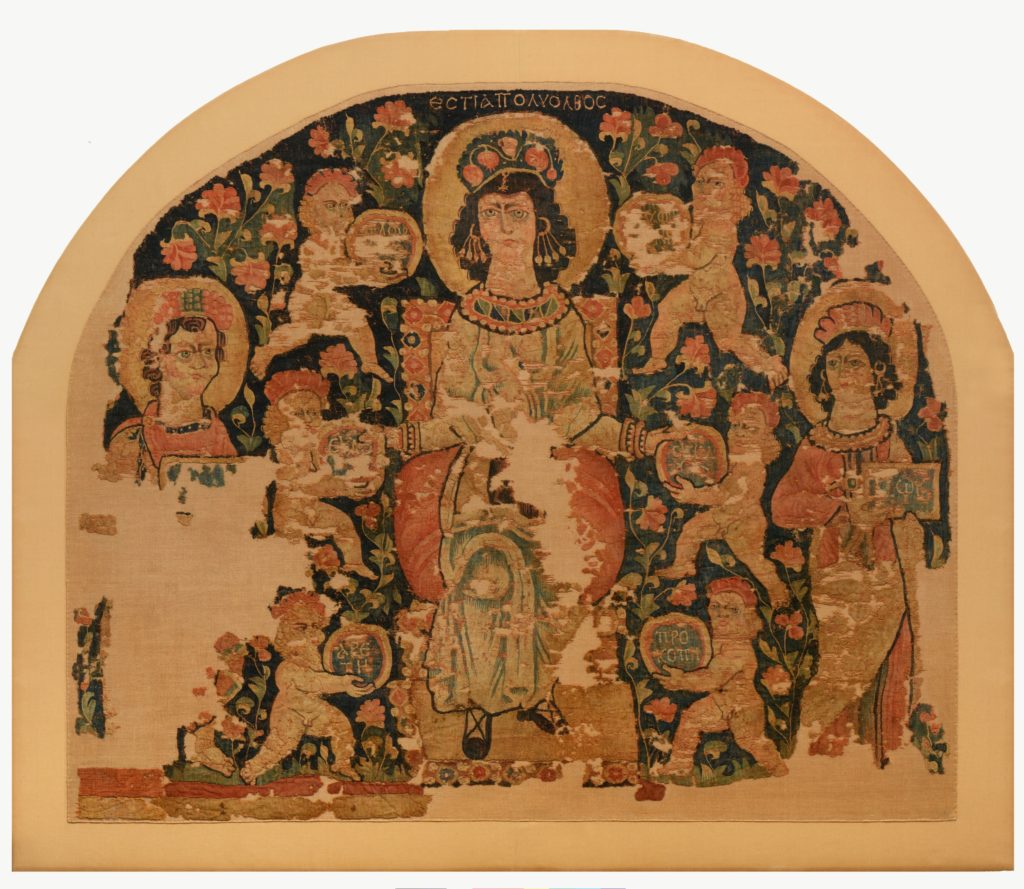
Hanging with Hestia Polyolbus, an Egyptian textile circa the 6th century.
Williams often finds that iconographic symbols are like over-Xeroxed photocopies. “You kind of get to an end stage of the iconography, and it starts looking like monster fish heads that might have been, in an earlier iteration, a very nicely woven flower,” she says.
In the center of a roundel in the Dumbarton Oaks collection, a rabbit-gazelle hybrid displays sharp claws and ears evoking Ren (you know, of Ren & Stimpy). In another fragment, animals may be dogs, rabbits, or gazelles—it isn’t clear. The museum catalogue doesn’t hazard a guess at the kind of long-necked animal a hunter holds in the roundel below. “It’s like a Rorschach test,” she says.
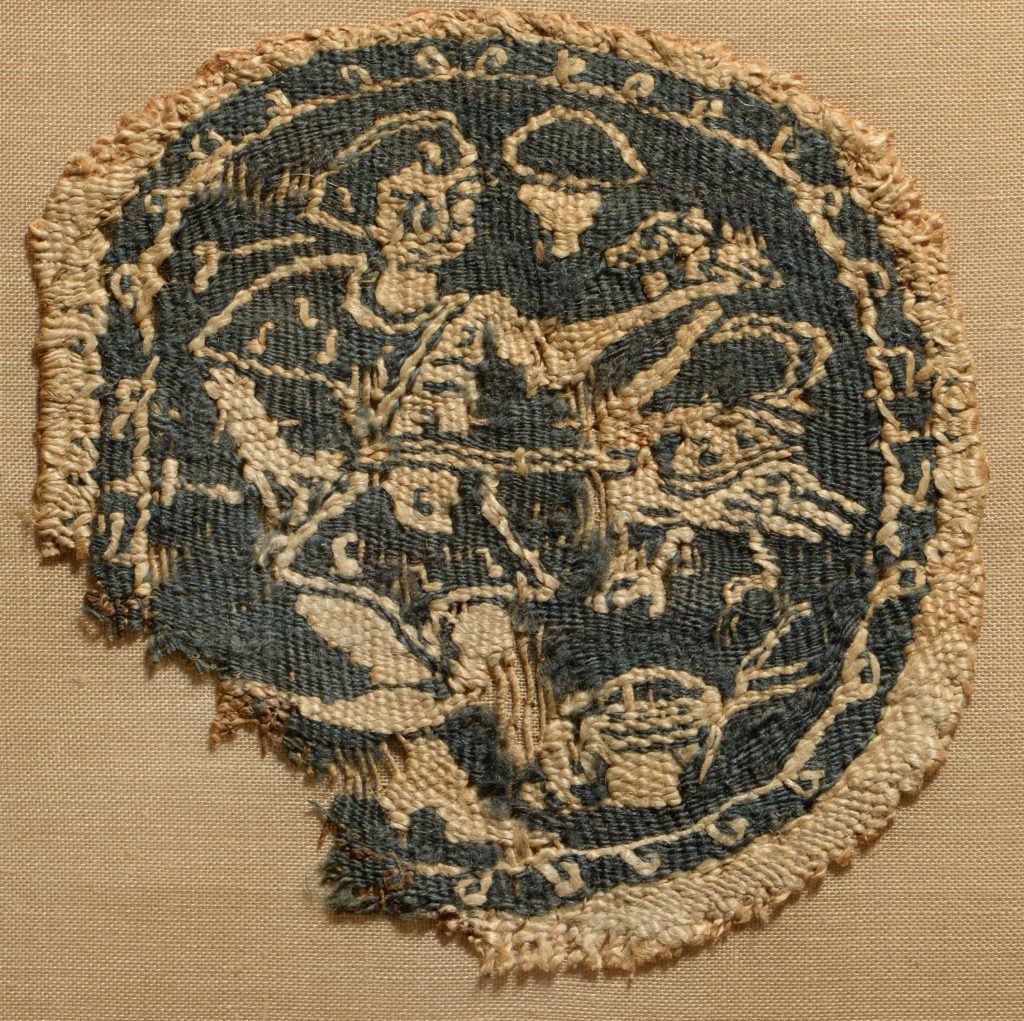
A roundel from the 4th to 7th century.
Looking at textiles in reproduction makes scale tough to gauge. Williams notes that a fragment depicting a figure’s face, neck, and chest—all measuring nearly eight by four inches—is too large to have been worn, so it could have been a hanging. “You don’t ever see this type of figure on a tunic,” she says.
Another fragment (see below) is part of a tunic sleeve, which Williams identifies based on a basic pattern—a figure flanked by plants and animals in a rectangular configuration—that surfaces in other sleeves. Most textiles are multiples, so one can generally do detective work by comparing pairs.
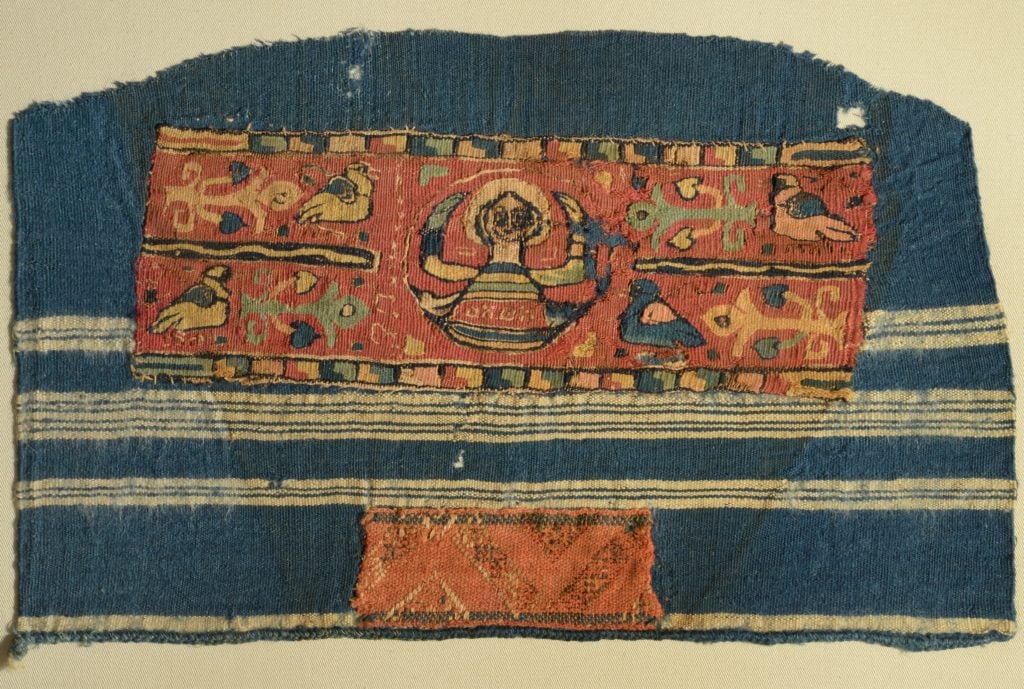
A tunic fragment from the 7th to 10th century
Most Byzantine textiles don’t have inscriptions, as very few people at the time could read them. “Just having script on it made it very valuable,” Williams says. She says that after Islam spread to Egypt in the 7th and 8th centuries, inscriptions proliferated, and people began to recognize that a phrase invoked the name of God or a ruler, even if they couldn’t literally read the words.
“They treated these textiles with a lot of respect,” she says. “When we find them in burials, they’re often wrapped around the head of the deceased, right over the eyes. The writing itself has this kind of draw or power.”
Most of the textiles in the Dumbarton Oaks collection belonged to wealthy people, who could afford to be buried in them. But in the Byzantine period, most people likely only owned a few garments across their entire lifetimes. “They didn’t go through tunics every year,” Williams says. “We are accustomed to H&M, fast fashion, and cheap materials. You can buy a t-shirt really cheaply and that’s just not how people in that time understood fabrics.”
The ways we consume (and discard) clothing today, as well as our disconnection from their manufacture, makes it harder for us to understand Byzantine textiles. “I think that people, maybe even as recently as their grandparents’ generation, had a better appreciation for fabrics and textiles,” Williams says. “It’s sort of lost today, somehow.”
It’s tempting to focus on the parts of a textile that remain preserved and beautiful, but deterioration reveals a piece’s bones. “The best place to look at textiles to see the structure is where there is decay or fray,” Williams says.
In a particularly fine, five-colored silk textile, a hero (Samson? Hercules?) wrestles a lion. Some edges look like they could have emerged from a fight with a great cat, but examining unraveled threads reveals how luxury objects were made. “It doesn’t get more glam than that silk,” Williams says of the work, which was preserved in a European monastery treasury, perhaps wrapping a relic.
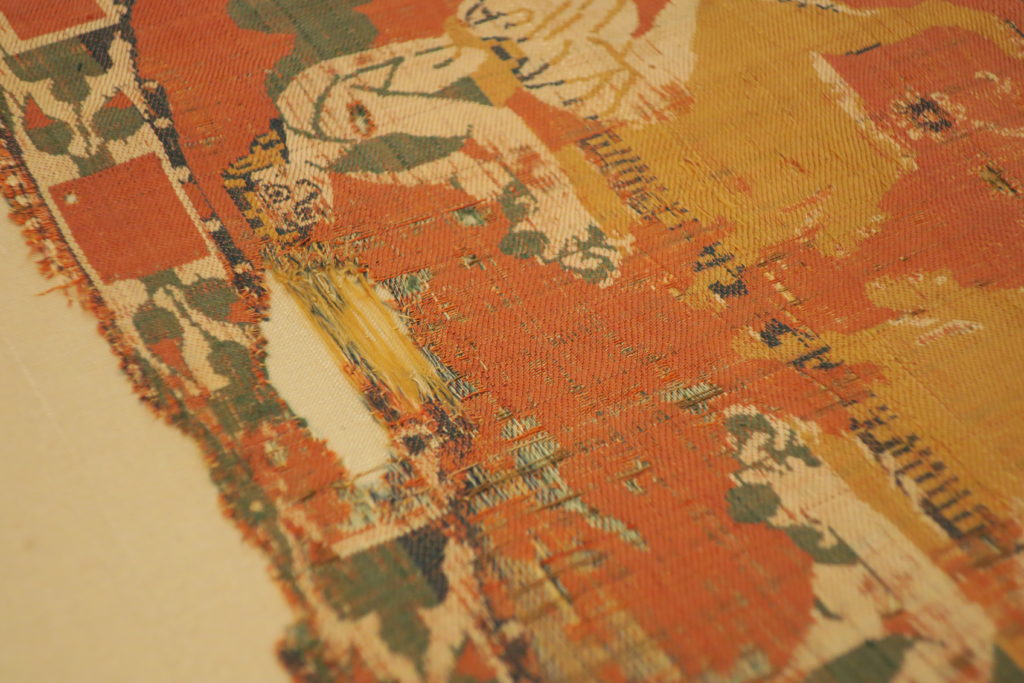
Detail of fraying on the “Hero and Lion” silk from Constantinople, Egypt,or Syria, circa the 7th to 9th century. Photo by Menachem Wecker.
“Textiles were some of the most valuable objects in people’s lives,” Williams says. The most valuable would be five-colored silks, and the techniques for making such works would have been kept secret, and the style trickled-down to imitation silks. The technology used for silk was cutting-edge. “A drawloom is basically a computer,” Williams says. “I think [the drawloom was] almost like the new Apple watch right now.”
Some of the pigments Byzantine artists used were chemically unstable; certain greens in particular have eaten away at the wool, and have disappeared. That’s the case with what appears to have been a lighter green shade that’s missing from fragments of a hanging in the Dumbarton Oaks collection.
“It’s often really hard to tell, just looking at the color today, what the color was back then,” Williams says. Many people are surprised that Byzantine textiles from Egypt—which they associate with desert sand—have bright colors at all. “They think terracotta, but in fact they’re really vibrant.”
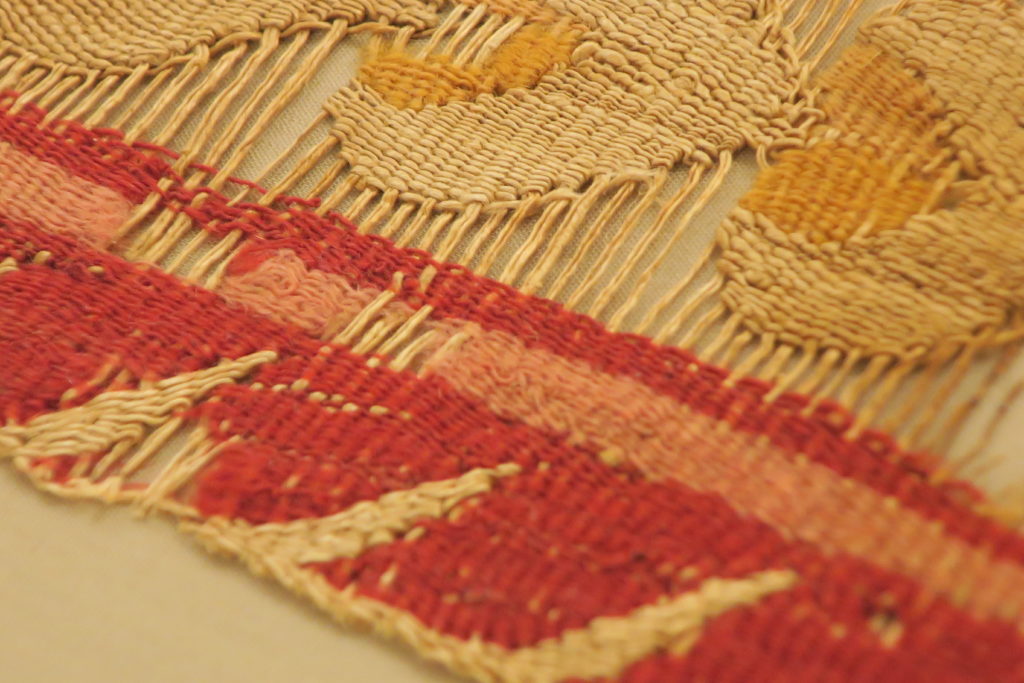
Detail of a fragment of an Egyptian band from the 4th to 10th century. Photo by Menachem Wecker.
Many fashion histories begin with the Renaissance and don’t give the Byzantine period credit for globalization. “We have a tendency to think of pre-modern people as being very entrenched in their dress habits, that they were wearing a toga for centuries,” Williams says. “It’s clear that that’s just not true.”
Indian-export textiles—many of which were thought to be from the 15th century, but which carbon dating reveals were made up to five centuries earlier—demonstrate how widely textiles traveled.
“They’re importing textiles really early on,” Williams says. “The scholarship is kind of catching up with that.”